Fly Ash and Natural Pozzolana Impacts on Sustainable Concrete Permeability and Mechanical Properties
Abstract
:1. Introduction
2. Experimental Work
2.1. Materials
2.2. Samples’ Preparation
2.3. Experimental Testing
2.3.1. FA and NA Particle Grades
2.3.2. Slump
2.3.3. Mechanical Properties
2.3.4. Permeability
2.3.5. Microstructural Analysis
2.3.6. Density Evolution
2.3.7. Cost Analysis
3. Results and Discussion
3.1. Particle Size Distribution (PSD)
3.2. Workability
3.3. Mechanical Properties
3.3.1. Compressive Strength Development
3.3.2. Flexural Strength
3.4. Water Permeability Test
3.5. Microstructural Properties
3.6. Density Evolution
3.7. Cost Analysis
4. Conclusions
- Replacing the cement with 30% FA and 30% NP improved the workability of fresh concrete by up to 66.6% and 55%, respectively, when compared with that of the control mix (0% FA or NP). This shows the importance of these pozzolanic materials in improving fresh concrete properties.
- The 56-day compressive strengths for the 10%, 20%, and 30% FA concrete batches increased by 11.63%, 1%, and 6.06%, respectively, compared to those of the control mixes. Meanwhile, the 56-day compressive strength for the 10% NP batch increased by 8.75% over that of the control mix;
- The 28-day flexural strengths for the 10, 20, 30, 40, and 50% FA concrete batches increased by 30.1, 26.8, 29.7, 25.1, and 15.6%, respectively, compared to those of the control mixes. The 28-day flexural strengths for the 10 and 20% NP concrete batches increased by 35.60 and 18.68%, respectively, compared to those of the control mixes;
- Class F fly ash and natural pozzolana improved the permeability of concrete mixes. The permeability for 50% FA and NP concrete batches decreased by 78.3% and 56.5%, respectively, compared to those of the control mixes;
- A microstructural analysis showed an improvement in the densification of the concrete matrix by adding FA and NP due to the formation of C-S-H crystals, which contributed to improved concrete performance;
- FA and NP concrete had an improved density after longer curing periods when compared with those of control mixes. The products of the pozzolanic reactions generally fill the pores and create a dense microstructure leading to improvements in the concrete properties;
- Based on the economic index results, the 10% FA concrete batch is the ideal one, followed by the 10% NP mix. Considering the environmental restrictions on FA, NP can be utilized instead with an optimum value of 10% replacement of cement content;
- The results obtained in this are consistent with the recommendations for the use of FA and NP in concrete admixtures, according to ASTM C618-17, which stipulates that Class F pozzolan can be used with a replacement ratio of 12–20% by the cement content.
Author Contributions
Funding
Data Availability Statement
Acknowledgments
Conflicts of Interest
References
- Da Silva, S.R.; Cimadon, F.N.; Borges, P.M.; Schiavon, J.Z.; Possan, E.; de Oliveira Andrade, J.J. Relationship between the mechanical properties and carbonation of concretes with construction and demolition waste. Case Stud. Constr. Mater. 2022, 16, e00860. [Google Scholar] [CrossRef]
- Ijaz, N.; Ye, W.; ur Rehman, Z.; Ijaz, Z. Novel application of low carbon limestone calcined clay cement (LC3) in expansive soil stabilization: An eco-efficient approach. J. Clean. Prod. 2022, 371, 133492. [Google Scholar] [CrossRef]
- Uzal, B.; Turanlı, L.; Yücel, H.; Göncüoğlu, M.C.; Çulfaz, A. Pozzolanic activity of clinoptilolite: A comparative study with silica fume, fly ash and a non-zeolitic natural pozzolan. Cem. Concr. Res. 2010, 40, 398–404. [Google Scholar] [CrossRef]
- Ghanim, A.A.; Rahman, F.U.; Adil, W.; Zeyad, A.M.; Magbool, H.M. Experimental investigation of industrial wastes in concrete: Mechanical and microstructural evaluation of pumice powder and Fly Ash in concrete. Case Stud. Constr. Mater. 2023, 18, e01999. [Google Scholar] [CrossRef]
- Golewski, G.L. Evaluation of morphology and size of cracks of the Interfacial Transition Zone (ITZ) in concrete containing fly ash (FA). J. Hazard. Mater. 2018, 357, 298–304. [Google Scholar] [CrossRef]
- Biricik, H.; Sarier, N. Comparative study of the characteristics of nano-silica-, silica fume-and fly ash-incorporated cement mortars. Mater. Res. 2014, 17, 570–582. [Google Scholar] [CrossRef]
- Ali, B.; Qureshi, L.A.; Shah, S.H.A.; Rehman, S.U.; Hussain, I.; Iqbal, M. A step towards durable, ductile and sustainable concrete: Simultaneous incorporation of recycled aggregates, glass fiber and fly ash. Constr. Build. Mater. 2020, 251, 118980. [Google Scholar] [CrossRef]
- De Maeijer, P.K.; Craeye, B.; Snellings, R.; Kazemi-Kamyab, H.; Loots, M.; Janssens, K.; Nuyts, G. Effect of ultra-fine fly ash on concrete performance and durability. Constr. Build. Mater. 2020, 263, 120493. [Google Scholar] [CrossRef]
- Teixeira, E.R.; Mateus, R.; Camoes, A.F.; Bragança, L.; Branco, F.G. Comparative environmental life-cycle analysis of concretes using biomass and coal fly ashes as partial cement replacement material. J. Clean. Prod. 2016, 112, 2221–2230. [Google Scholar] [CrossRef] [Green Version]
- De Matos, P.R.; Foiato, M.; Prudêncio, L.R., Jr. Ecological, fresh state and long-term mechanical properties of high-volume fly ash high-performance self-compacting concrete. Constr. Build. Mater. 2019, 203, 282–293. [Google Scholar] [CrossRef]
- Huang, C.H.; Lin, S.K.; Chang, C.S.; Chen, H.J. Mix proportions and mechanical properties of concrete containing very high-volume of Class F fly ash. Constr. Build. Mater. 2013, 46, 71–78. [Google Scholar] [CrossRef]
- Bakharev, T. Thermal behaviour of geopolymers prepared using class F fly ash and elevated temperature curing. Cem. Concr. Res. 2006, 36, 1134–1147. [Google Scholar] [CrossRef]
- Siddique, R. Effect of fine aggregate replacement with Class F fly ash on the mechanical properties of concrete. Cem. Concr. Res. 2003, 33, 539–547. [Google Scholar] [CrossRef]
- Sadowski, T.; Golewski, G.L. A failure analysis of concrete composites incorporating fly ash during torsional loading. Compos. Struct. 2018, 183, 527–535. [Google Scholar] [CrossRef]
- Golewski, G.L. Effect of curing time on the fracture toughness of fly ash concrete composites. Compos. Struct. 2018, 185, 105–112. [Google Scholar] [CrossRef]
- Golewski, G.L. Improvement of fracture toughness of green concrete as a result of addition of coal fly ash. Characterization of fly ash microstructure. Mater. Charact. 2017, 134, 335–346. [Google Scholar] [CrossRef]
- Chindaprasirt, P.; Rukzon, S. Strength, porosity and corrosion resistance of ternary blend Portland cement, rice husk ash and fly ash mortar. Constr. Build. Mater. 2008, 22, 1601–1606. [Google Scholar] [CrossRef]
- Nadeem, A.; Memon, S.A.; Lo, T.Y. The performance of fly ash and metakaolin concrete at elevated temperatures. Constr. Build. Mater. 2014, 62, 67–76. [Google Scholar] [CrossRef]
- Golewski, G.L. Green concrete composite incorporating fly ash with high strength and fracture toughness. J. Clean. Prod. 2018, 172, 218–226. [Google Scholar] [CrossRef]
- Cano, R.I. Evaluation of Natural Pozzolans as Replacements for Class F Fly Ash in Portland Cement Concrete. Ph.D. Thesis, The University of Texas at Austin, Austin, TX, USA, 2013. Available online: http://hdl.handle.net/2152/23563 (accessed on 1 April 2023).
- Liu, J.; Wang, Z.; Xie, G.; Li, Z.; Fan, X.; Zhang, W.; Xing, F.; Tang, L.; Ren, J. Resource utilization of municipal solid waste incineration fly ash-cement and alkali-activated cementitious materials: A review. Sci. Total Environ. 2022, 852, 158254. [Google Scholar] [CrossRef]
- Li, Z.; Zhang, W.; Jin, H.; Fan, X.; Liu, J.; Xing, F.; Tang, L. Research on the durability and Sustainability of an artificial lightweight aggregate concrete made from municipal solid waste incinerator bottom ash (MSWIBA). Constr. Build. Mater. 2023, 365, 129993. [Google Scholar] [CrossRef]
- Hossain, M.U.; Cai, R.; Ng, S.T.; Xuan, D.; Ye, H. Sustainable natural pozzolana concrete–A comparative study on its environmental performance against concretes with other industrial by-products. Constr. Build. Mater. 2021, 270, 121429. [Google Scholar] [CrossRef]
- Shukla, A.; Gupta, N.; Gupta, A.; Goel, R.; Kumar, S. Natural Pozzolans a Comparative Study: A Review. IOP Conf. Ser. Mater. Sci. Eng. 2020, 804, 012040. [Google Scholar] [CrossRef]
- Rodrıguez-Camacho, R.E.; Uribe-Afif, R. Importance of using the natural pozzolans on concrete durability. Cem. Concr. Res. 2002, 32, 1851–1858. [Google Scholar] [CrossRef]
- Ghrici, M.; Kenai, S.; Said-Mansour, M. Mechanical properties and durability of mortar and concrete containing natural pozzolana and limestone blended cements. Cem. Concr. Compos. 2007, 29, 542–549. [Google Scholar] [CrossRef]
- Liu, J.C.; Hossain, M.U.; Ng, S.T.; Ye, H. High-performance green concrete with high-volume natural pozzolan: Mechanical, carbon emission and cost analysis. J. Build. Eng. 2023, 68, 106087. [Google Scholar] [CrossRef]
- Khan, M.I.; Alhozaimy, A.M. Properties of natural pozzolan and its potential utilization in environmental friendly concrete. Can. J. Civ. Eng. 2011, 38, 71–78. [Google Scholar] [CrossRef]
- Ababneh, A.; Matalkah, F. Potential use of Jordanian volcanic tuffs as supplementary cementitious materials. Case Stud. Constr. Mater. 2018, 8, 193–202. [Google Scholar] [CrossRef]
- Espinoza-Hijazin, G.; Paul, Á.; Lopez, M. Concrete containing natural pozzolans: New challenges for internal curing. J. Mater. Civ. Eng. 2012, 24, 981–988. [Google Scholar] [CrossRef]
- Hossain, M.U.; Sohail, A.; Ng, S.T. Developing a GHG-based methodological approach to support the sourcing of sustainable construction materials and products. Resour. Conserv. Recycl. 2019, 145, 160–169. [Google Scholar] [CrossRef]
- Turanli, L.; Uzal, B.; Bektas, F. Effect of large amounts of natural pozzolan addition on properties of blended cements. Cem. Concr. Res. 2005, 35, 1106–1111. [Google Scholar] [CrossRef]
- Alonzo, O.; Barringer, W.L.; Barton, S.G.; Bell, L.W.; Bennett, J.E.; Boyle, M.; Burg, G.R.; Carrasquillo, R.L.; Cook, J.E.; Cook, R.A.; et al. Guide for selecting proportions for high-strength concrete with portland cement and fly ash. ACI Mater. J. 1993, 90, 272–283. Available online: http://civilwares.free.fr/ACI/MCP04/2114r_93.pdf (accessed on 15 March 2023).
- ASTM C143; Standard Test Method for Slump of Hydraulic-Cement Concrete. Annual Book of ASTM Standards. ASTM International: West Conshohocken, PA, USA, 2015. Available online: https://www.astm.org/c0143_c0143m-12.html (accessed on 26 March 2023).
- ASTM C39/C39M17; Standard Test Method for Compressive Strength of Cylindrical Concrete Specimens. ASTM International: West Conshohocken, PA, USA, 2017; p. 8. Available online: https://scirp.org/reference/referencespapers.aspx?referenceid=1855281 (accessed on 26 March 2023).
- ASTM C78/C78M16; Standard Test Method for Flexural Strength of Concrete (Using Simple Beam with Third-Point Loading). ASTM International: West Conshohocken, PA, USA, 2016; p. 4. Available online: https://normanray.files.wordpress.com/2010/10/kuliah-7-c78.pdf (accessed on 26 March 2023).
- DIN 1048 (Part 5); Determination of Permeability of Concrete. Deutsches Institut fur Normung: Berlin, Germany, 1991. Available online: http://www.sciepub.com/reference/70151 (accessed on 26 March 2023).
- Mohapatra, B.N.; Kaura, P.; Ojha, P.N.; Singh, B.; Kumar, S.; Liju, V. Fresh, hardened and durability properties of concrete made with flyash and limestone based Portland composite cement. J. Asian Concr. Fed. 2023, 9, 1–16. [Google Scholar] [CrossRef]
- Bashar, S.M.; Ong, C.F. Assessing the properties of freshly mixed concrete containing paper-mill residuals and class F fly ash. J. Civ. Eng. Constr. Technol. 2011, 2, 17–26. [Google Scholar]
- Wang, J.; Liu, M.; Wang, Y.; Zhou, Z.; Xu, D.; Du, P.; Cheng, X. Synergistic effects of nano-silica and fly ash on properties of cement-based composites. Constr. Build. Mater. 2020, 262, 120737. [Google Scholar] [CrossRef]
- Cavdar, A.; Yetgin, Ş. Availability of tuffs from northeast of Turkey as natural pozzolan on cement, some chemical and mechanical relationships. Constr. Build. Mater. 2007, 21, 2066–2071. [Google Scholar] [CrossRef]
- Nazari, A.; Riahi, S.; Riahi, S.; Shamekhi, S.F.; Khademno, A. Influence of Al2O3 nanoparticles on the compressive strength and workability of blended concrete. J. Am. Sci. 2010, 6, 6–9. [Google Scholar]
- Thomas, M.D.A. Optimizing the Use of Fly Ash in Concrete; Portland Cement Association: Skokie, IL, USA, 2007; Volume 5420, Available online: https://www.cement.org/docs/default-source/fc_concrete_technology/is548-optimizing-the-use-of-fly-ash-concrete.pdf (accessed on 15 March 2023).
- Khankhaje, E.; Kim, T.; Jang, H.; Kim, C.-S.; Kim, J.; Rafieizonooz, M. Properties of pervious concrete incorporating fly ash as partial replacement of cement: A review. Dev. Built. Environ. 2023, 14, 100130. [Google Scholar] [CrossRef]
- Abd Elrahman, M.; Hillemeier, B. Combined effect of fine fly ash and packing density on the properties of high performance concrete: An experimental approach. Constr. Build. Mater. 2014, 58, 225–233. [Google Scholar] [CrossRef]
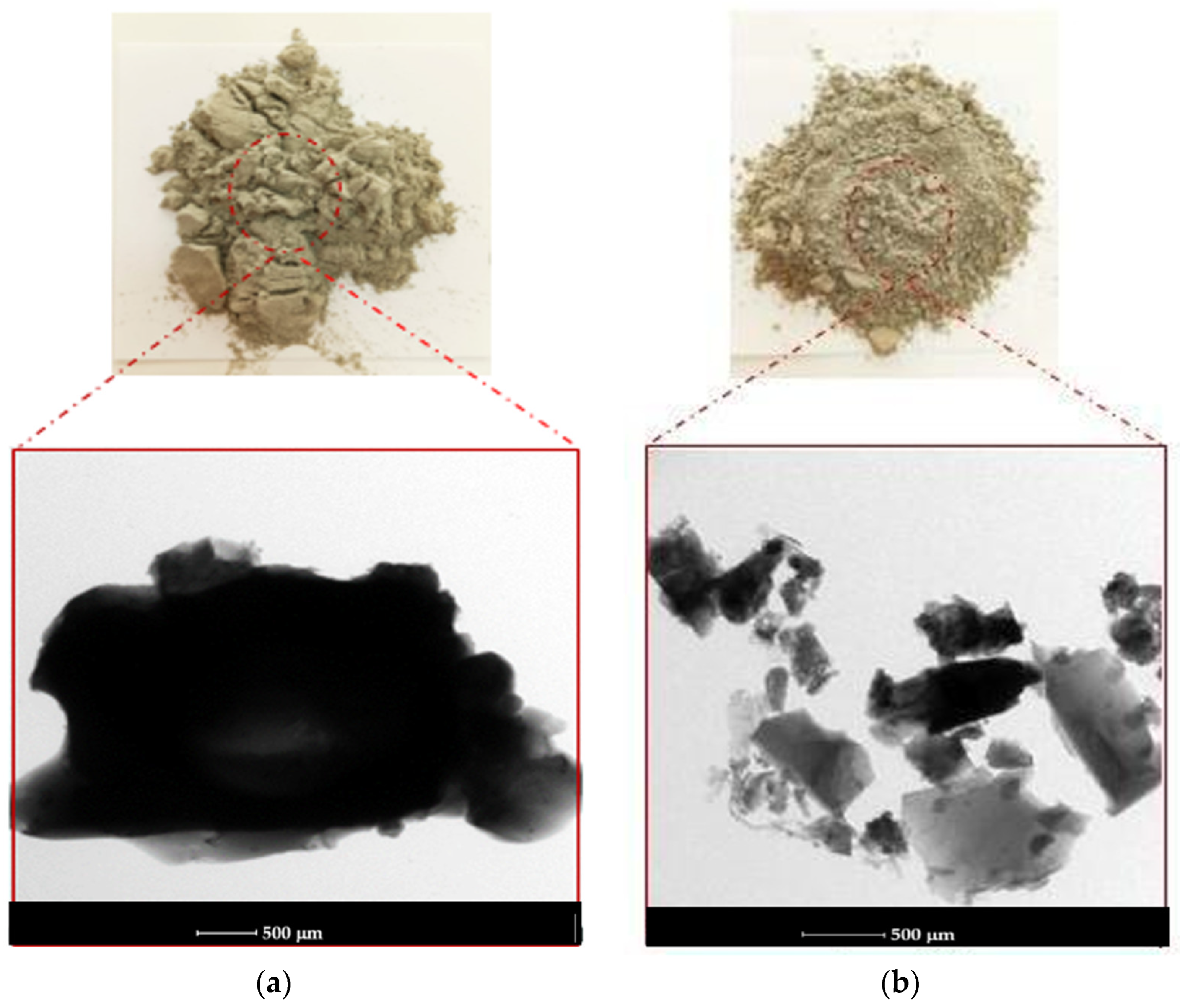
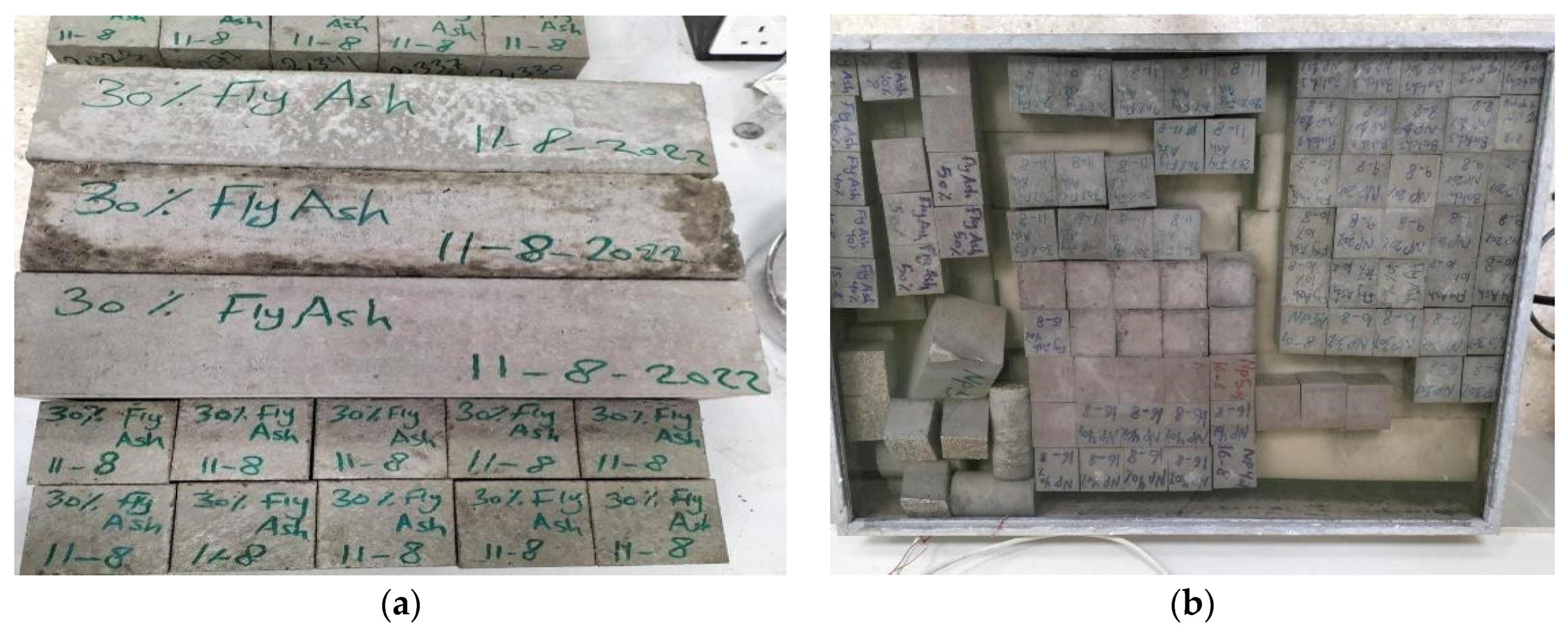
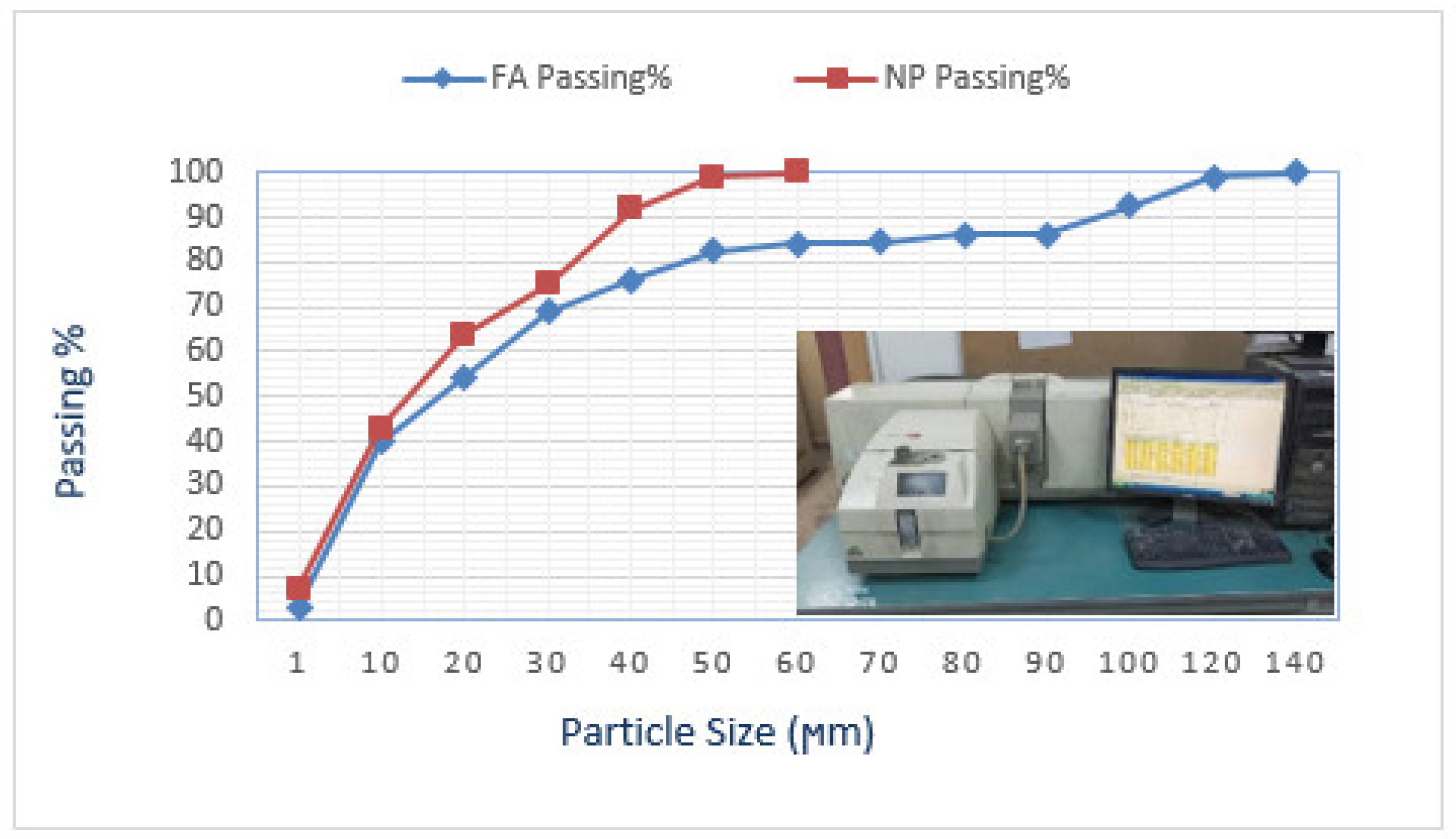
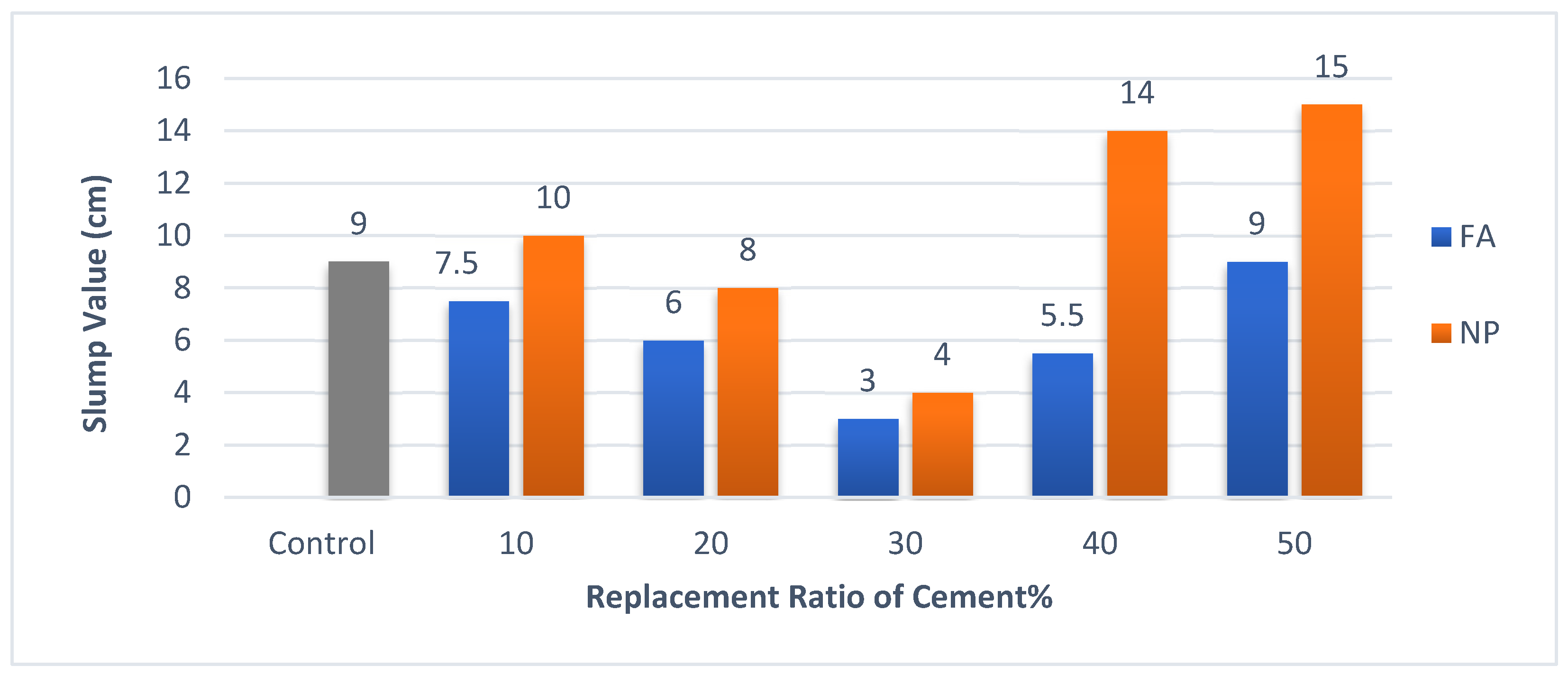
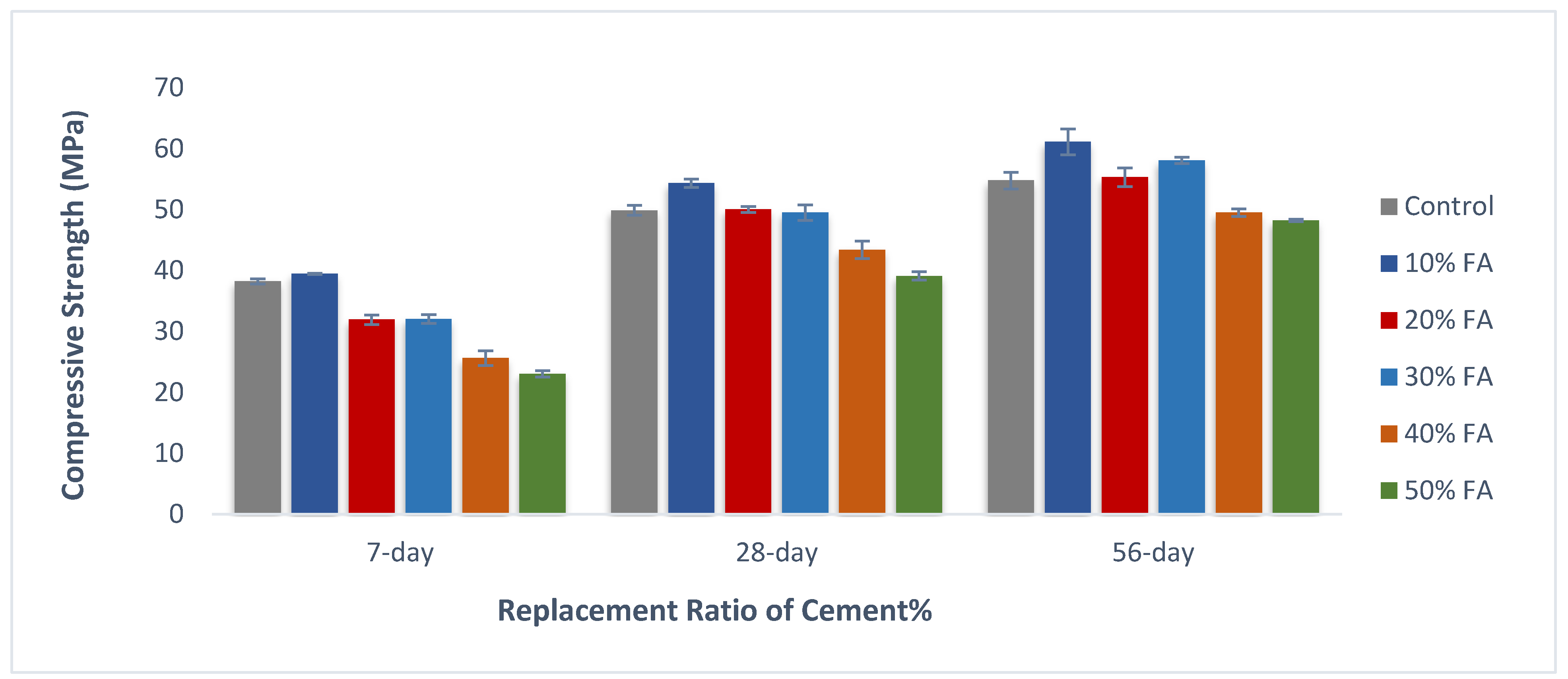
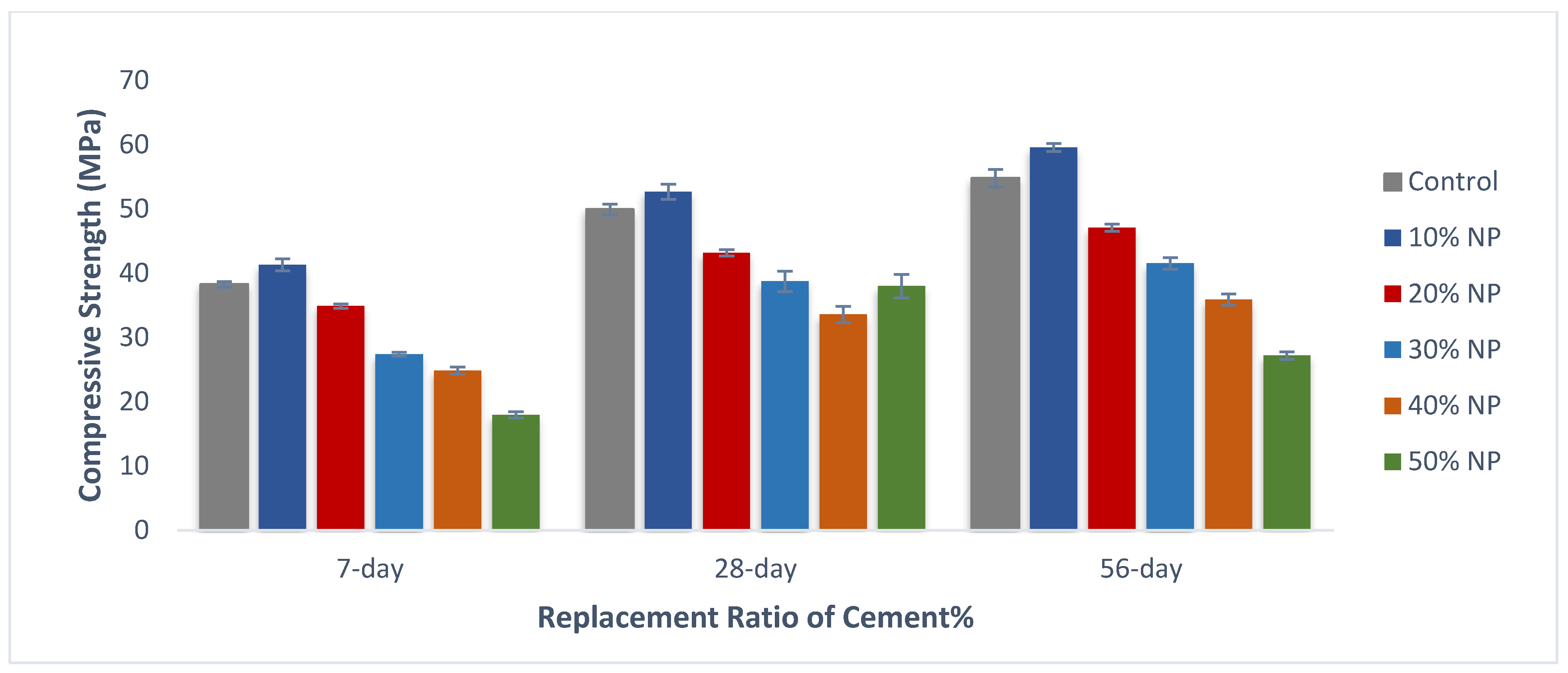
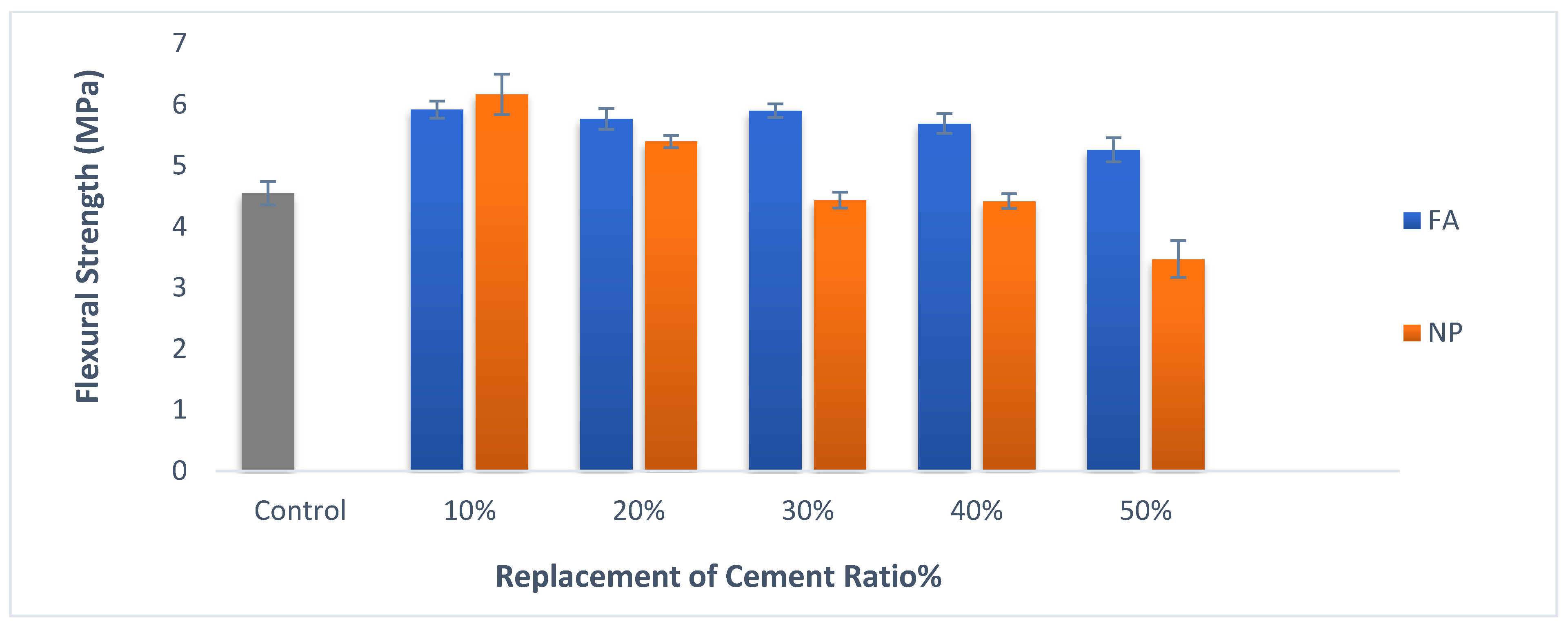
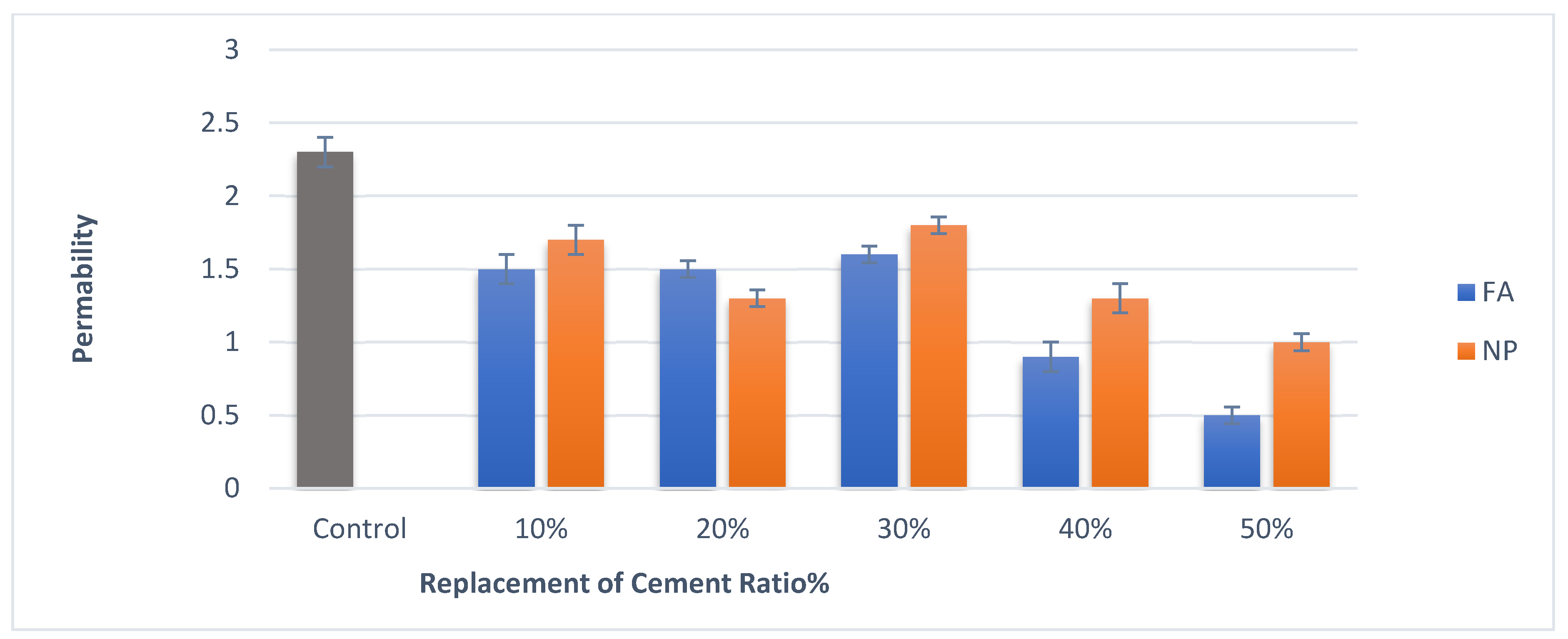




| Compound | Content (%) | Specification (%) | Testing Method |
|---|---|---|---|
| SiO2 | 24.0 ± 0.5 | - | X-ray |
| Al2O3 | 6.5 ± 0.5 | - | X-ray |
| Fe2O3 | 6.5 ± 0.5 | - | X-ray |
| CaO | 52.5 ± 1.0 | - | X-ray |
| MgO | 3.2 ± 0.5 | - | X-ray |
| SO3 | 2.60 ± 0.2 | ≥3.5% | X-ray |
| K2O | 0.8 ± 0.1 | - | X-ray |
| Na2O | 0.95 ± 0.1 | - | X-ray |
| Cl | 0.04 | ≥0.10% | EN 196-2 |
| Property | Unit | Result | Specification | Testing Method |
|---|---|---|---|---|
| Finesses (Blaine) | cm2/g | 4000 | EN 196-6:1992 | |
| Fineness (Residue)—45 µm | % | 2.5 | EN 196-6:1992 | |
| Initial setting time | Minutes | 160 | ≥60 | JS 1470-3/05 EN 196-3:2005 |
| Final setting time | Minutes | 225 | JS 1470-3/05 EN 196-3:2005 | |
| Water/cement ratio | % | 29.6 | JS 1470-3/05 EN 196-3:2005 | |
| Soundness | Mm | ≤10.0 | JS 1470-3/05 EN 196-3:2005 | |
| 2-day compressive strength | MPa | 24.0 | ≥10.0 | JS 1470-3/05 EN 196-1:2005 |
| 28-day compressive strength | MPa | 49.0 | ≥42.5 ≤ 62.5 | JS 1470-3/05 EN 196-1:2005 |
| Appearance | Brown Liquid |
|---|---|
| Specific Gravity | 1.10 ± 0.03 g/cm3 |
| pH Value | 6.0 ± 1 |
| Chloride Content (%) | ≤0.10 by mass |
| Compound | Class F Fly Ash | Class N Natural Pozzolana |
|---|---|---|
| Composition (%) | ||
| CaO | 1.34 | 9.54 |
| Al2O₃ | 18.21 | 14.38 |
| SiO2 | 70.31 | 47.85 |
| Fe2O₃ | 5.26 | 12.99 |
| MgO | 1.00 | 9.63 |
| K2O | 1.08 | 1.14 |
| Physical Properties | ||
| Moisture content max% | 3 | 0.4–1.2 |
| Loss on ignition, max% | 6 | 0.8–1.2 |
| Fineness% retained on 45 micron-sieving, max% | 34 | 1.7–3.3 |
| Ingredients | Quantity | ||||||||||
|---|---|---|---|---|---|---|---|---|---|---|---|
| Batch 1 | Batch 2 | Batch 3 | Batch 4 | Batch 5 | Batch 6 | Batch 7 | Batch 8 | Batch 9 | Batch 10 | Batch 11 | |
| Cement (kg) | 20 | 18 | 16 | 14 | 12 | 10 | 18 | 16 | 14 | 12 | 10 |
| Fly Ash (kg) | - | 2 | 4 | 6 | 8 | 10 | - | - | - | - | - |
| Natural Pozzolana (kg) | - | - | - | - | - | - | 2 | 4 | 6 | 8 | 10 |
| Coarse Aggregate (kg) | 50 | ||||||||||
| Fine Aggregate (kg) | 46 | ||||||||||
| Water (kg) | 10 | ||||||||||
| Superplasticizer (g) | 200 | ||||||||||
| # | Batch | Compressive Strength (MPa) | Flexural Strength (MPa) | ||||||
|---|---|---|---|---|---|---|---|---|---|
| 7 Days | Change % | 28 Days | Change % | 56 Days | Change % | 28 Days | Change % | ||
| 1 | Control | 38.24 | - | 49.90 | - | 54.77 | - | 4.55 | - |
| 2 | 10% FA | 39.48 | +3.24 | 54.35 | +8.92 | 61.14 | +11.63 | 5.92 | +30.11 |
| 3 | 20% FA | 31.95 | −16.45 | 50.05 | +0.30 | 55.32 | +1.00 | 5.77 | +26.81 |
| 4 | 30% FA | 32.05 | −16.19 | 49.52 | −0.76 | 58.09 | +6.06 | 5.90 | +29.67 |
| 5 | 40% FA | 25.63 | −32.98 | 43.43 | −12.97 | 49.52 | −9.59 | 5.69 | +25.05 |
| 6 | 50% FA | 23.05 | −39.72 | 39.12 | −21.60 | 48.24 | −11.92 | 5.26 | +15.60 |
| 7 | 10% NP | 41.28 | +7.95 | 52.67 | +5.55 | 59.56 | +8.75 | 6.17 | +35.60 |
| 8 | 20% NP | 34.88 | −8.79 | 43.15 | −13.53 | 47.06 | −14.08 | 5.40 | +18.68 |
| 9 | 30% NP | 27.37 | −28.43 | 38.71 | −22.42 | 41.51 | −24.21 | 4.44 | −2.42 |
| 10 | 40% NP | 24.85 | −35.02 | 33.54 | −32.79 | 35.89 | −34.47 | 4.42 | −2.86 |
| 11 | 50% NP | 17.95 | −53.06 | 37.97 | −23.91 | 27.15 | −50.43 | 3.47 | −23.74 |
| Specimen | Control | 10% FA | 20% FA | 30% FA | 40% FA | 50% FA | 10% NP | 20% NP | 30% NP | 40% NP | 50% NP |
| Ca/Si ratio | 2.83 | 1.41 | 1.75 | 1.68 | 3.40 | 3.58 | 2.51 | 3.50 | 3.75 | 4.38 | 4.69 |
| Batch Name | Before Curing | After Curing at 7 Days | After Curing at 28 Days | After Curing at 56 Days | |||
|---|---|---|---|---|---|---|---|
| Density (kg/m3) | Density (kg/m3) | Density Difference (∆) (kg/m3) | Density (kg/m3) | Density Difference (∆) (kg/m3) | Density (kg/m3) | Density Difference (∆) (kg/m3) | |
| Control | 2350 | 2355 | 5.0 | 2362 | 12.0 | 2369 | 19.0 |
| 10% FA | 2331 | 2359 | 28.0 | 2362 | 31.0 | 2362 | 31.0 |
| 20% FA | 2328 | 2354 | 26.0 | 2368 | 40.0 | 2368 | 40.0 |
| 30% FA | 2350 | 2388 | 38.0 | 2392 | 42.0 | 2390 | 40.0 |
| 40% FA | 2281 | 2304 | 23.0 | 2308 | 27.0 | 2309 | 28.0 |
| 50% FA | 2281 | 2308 | 27.0 | 2309 | 28.0 | 2312 | 31.0 |
| 10% NP | 2333 | 2358 | 25.0 | 2367 | 34.0 | 2366 | 33.0 |
| 20% NP | 2330 | 2354 | 24.0 | 2362 | 32.0 | 2362 | 32.0 |
| 30% NP | 2333 | 2355 | 22.0 | 2361 | 28.0 | 2361 | 28.0 |
| 40% NP | 2337 | 2350 | 13.0 | 2353 | 16.0 | 2352 | 15.0 |
| 50% NP | 2338 | 2352 | 14.0 | 2352 | 14.0 | 2352 | 14.0 |
| Material | FA | NP | W | PC | C.Agg | F.Agg | SF | Total (USD) | Compressive Strength (MPa) | Economy Index (EI) (Str/Cost) |
|---|---|---|---|---|---|---|---|---|---|---|
| Unit | kg | kg | ltr | kg | kg | kg | ltr | |||
| Price (USD) | 0.052 | 0.09 | 0.5 | 0.14 | 0.03 | 0.028 | 2.5 | |||
| Batch | Combination Cost | |||||||||
| Control | 0 | 0 | 0.56 | 0.4 | 1.5 | 1.29 | 0.5 | 4.25 | 54.77 | 12.89 |
| 10% FA | 0.104 | 0 | 0.56 | 0.4 | 1.5 | 1.29 | 0.5 | 4.354 | 61.14 | 14.04 |
| 20% FA | 0.208 | 0 | 0.56 | 0.4 | 1.5 | 1.29 | 0.5 | 4.458 | 55.32 | 12.41 |
| 30% FA | 0.312 | 0 | 0.56 | 0.4 | 1.5 | 1.29 | 0.5 | 4.562 | 58.09 | 12.73 |
| 40% FA | 0.416 | 0 | 0.56 | 0.4 | 1.5 | 1.29 | 0.5 | 4.666 | 49.52 | 10.61 |
| 50% FA | 0.52 | 0 | 0.56 | 0.4 | 1.5 | 1.29 | 0.5 | 4.77 | 48.24 | 10.11 |
| 10% NP | 0 | 0.18 | 0.56 | 0.4 | 1.5 | 1.29 | 0.5 | 4.43 | 59.56 | 13.45 |
| 20% NP | 0 | 0.36 | 0.56 | 0.4 | 1.5 | 1.29 | 0.5 | 4.61 | 47.06 | 10.21 |
| 30% NP | 0 | 0.54 | 0.56 | 0.4 | 1.5 | 1.29 | 0.5 | 4.79 | 41.51 | 8.67 |
| 40% NP | 0 | 0.72 | 0.56 | 0.4 | 1.5 | 1.29 | 0.5 | 4.97 | 35.89 | 7.22 |
| 50% NP | 0 | 0.9 | 0.56 | 0.4 | 1.5 | 1.29 | 0.5 | 5.15 | 27.15 | 5.27 |
Disclaimer/Publisher’s Note: The statements, opinions and data contained in all publications are solely those of the individual author(s) and contributor(s) and not of MDPI and/or the editor(s). MDPI and/or the editor(s) disclaim responsibility for any injury to people or property resulting from any ideas, methods, instructions or products referred to in the content. |
© 2023 by the authors. Licensee MDPI, Basel, Switzerland. This article is an open access article distributed under the terms and conditions of the Creative Commons Attribution (CC BY) license (https://creativecommons.org/licenses/by/4.0/).
Share and Cite
Mohsen, M.O.; Aburumman, M.O.; Al Diseet, M.M.; Taha, R.; Abdel-Jaber, M.; Senouci, A.; Abu Taqa, A. Fly Ash and Natural Pozzolana Impacts on Sustainable Concrete Permeability and Mechanical Properties. Buildings 2023, 13, 1927. https://doi.org/10.3390/buildings13081927
Mohsen MO, Aburumman MO, Al Diseet MM, Taha R, Abdel-Jaber M, Senouci A, Abu Taqa A. Fly Ash and Natural Pozzolana Impacts on Sustainable Concrete Permeability and Mechanical Properties. Buildings. 2023; 13(8):1927. https://doi.org/10.3390/buildings13081927
Chicago/Turabian StyleMohsen, Mohamed O., Mervat O. Aburumman, Malak M. Al Diseet, Ramzi Taha, Mu’tasim Abdel-Jaber, Ahmed Senouci, and Ala Abu Taqa. 2023. "Fly Ash and Natural Pozzolana Impacts on Sustainable Concrete Permeability and Mechanical Properties" Buildings 13, no. 8: 1927. https://doi.org/10.3390/buildings13081927






